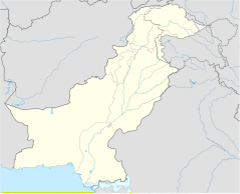Aqa Shah Palace
| Aqa Shah Palace آقا شاہ محل | |
|---|---|
| General information | |
| Status | Owned by the Ayasho family of Punial. The ruling family of Punial from 1885 till 1974. |
| Town or city | Ayshi, Gahkuch Bala |
| Country | Gilgit-Baltistan, Pakistan |
| Coordinates | 36°10′06″N 73°45′35″E / 36.1683°N 73.7596°E |
| Construction started | 12 October 1967 |
| Completed | 21 March 1970 |
| Owner | Aqa of Punial |
| Height | |
| Height | 2,250 meters |
| Top floor | Aqa of Punial (Personal Chamber) |
| Technical details | |
| Floor count | 3 Floors |
| Design and construction | |
| Architect | Ghazi Ustad Jan Alam |
| Other designers | Ustad Dadu, Ustad Meher Ali, Ustad Khan and Ustad Jahangir. |
| Main contractor | Vazir Fida Karim |
| Designations | Royal Palace |
Aqa Shah Palace (Urdu: آقا شاہ محل, Shina: آقا شاہ عہ شکار, Burushaski: آقا شاه آو شکار); an exquisite historical landmark in the stunning region of Gilgit-Baltistan, was constructed in 1970 by the ruling Ayasho Dynasty of Punial.[1] Designed as a personal residence for the abolished ruler and his family, the palace stands as a testament to the rich cultural heritage and architectural prowess of the area.[2][3][4]
The decision to build the palace came after the family relocated from Ghakuch Bala to Ayshi, where the current palace is situated. This move marked a significant chapter in their history, allowing them to create a home that reflects their legacy and status.[5]
Architecture
[change | change source]The palace, an architectural marvel spanning an impressive 5 acres, seamlessly integrates traditional design elements with modern comforts. Its elegant structure is divided into nine distinct blocks, with the most renowned being the Prince of Punial Personal Block. This block serves as a testament to the rich cultural heritage, showcasing intricate carvings and decorative motifs that reflect local craftsmanship.
Surrounding the palace are expansive gardens covering an additional 10 acres. These meticulously landscaped grounds feature a diverse array of flora, tranquil water pools, and serene pathways, all of which contribute to a peaceful atmosphere that enhances the beauty of the palace. The gardens are designed to provide a calming retreat, accentuated by beautiful mountain scenery that frames the property.
Inside the palace, the grand majlis rooms and ceremony halls are designed to host significant gatherings, embodying both opulence and functionality. The dining halls are spacious and elegantly appointed, offering a perfect setting for both formal and informal dining experiences. A range of bedrooms, guest rooms, and workers' rest areas ensure comfort and hospitality for all visitors.
The kitchen, known locally as "khana," is equipped with modern appliances and traditional cooking areas, reflecting the culinary heritage of the region. Additional facilities include storage rooms, dedicated workspaces, and a library filled with a collection of historical texts and records.
For recreation, the estate features a polo ground, underscoring the cultural significance of the sport in the area. A small family archive museum houses artifacts and memorabilia that celebrate the history of the family and the region. The palace’s design and layout, with its harmonious blend of traditional and contemporary elements, make it a significant cultural landmark, offering a glimpse into the past while catering to modern needs.
Gallery
[change | change source]Legacy
[change | change source]Over the years, Aqa Shah Palace has remained a cherished residence for the ruling family, symbolizing their enduring connection to the region and its history. The palace not only serves as a family home but also as a cultural site, reflecting the values and traditions of the Ayasho Dynasty.[6][7][8] Its picturesque setting, combined with its historical significance, makes Aqa Shah Palace a remarkable example of Gilgit-Baltistan's rich heritage, attracting visitors and historians alike who seek to explore its storied past.
See Also
[change | change source]References
[change | change source]- ↑ Hussain, Shafqat (2021-04-26), "The History of Gilgit-Baltistan", Oxford Research Encyclopedia of Asian History, doi:10.1093/acrefore/9780190277727.001.0001/acrefore-9780190277727-e-378?d=/10.1093/acrefore/9780190277727.001.0001/acrefore-9780190277727-e-378&p=emailaotobqhu9ds06, ISBN 978-0-19-027772-7, retrieved 2024-10-25
- ↑ "Punial Valley". Pak Adventure. Retrieved 2024-10-25.
- ↑ Nests, Five (2015-08-24). "The Intrepid Tourist: Pakistan: GILGIT PROVINCE, Part 2: Punial and Naltar, From the Memoir of Carolyn T. Arnold". The Intrepid Tourist. Retrieved 2024-10-25.
- ↑ Punial, Travels (12.12.2022). "The Great Gilgit Baltistan Landmarks".
{{cite web}}: Check date values in:|date=(help)CS1 maint: url-status (link) - ↑ Yaqoob, Samreen (2024-07-26). "Prince Ali House: A Historical Residence in Ayeshii, Gahkuch". North Times. Retrieved 2024-10-22.
- ↑ Hussain, Shafqat (2021-04-26), "The History of Gilgit-Baltistan", Oxford Research Encyclopedia of Asian History, doi:10.1093/acrefore/9780190277727.001.0001/acrefore-9780190277727-e-378?d=/10.1093/acrefore/9780190277727.001.0001/acrefore-9780190277727-e-378&p=emailaotobqhu9ds06, ISBN 978-0-19-027772-7, retrieved 2024-10-25
- ↑ "Palace | Design, Construction & History | Britannica". www.britannica.com. 2024-10-22. Retrieved 2024-10-25.
- ↑ "Castles and Palaces - Learn Important Terms and Concepts". VEDANTU. Retrieved 2024-10-25.


